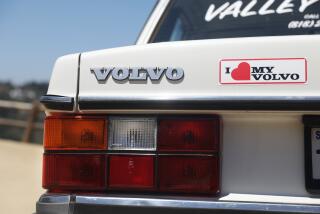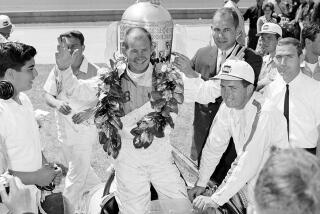My Car, My Self : How Many Cars on the Road Today Employ the Same Wood-and-Canvas Door Construction That the British Used in Their World War I Sopwith Camels?
- Share via
If you own a 22-year-old car, you expect your breakdown ratio to be somewhat higher than, say, that of a 3-year-old Nissan Sentra. If your 22-year-old car happens to be a British sports car, your ratio is considerably higher yet. You listen to the jokes about British ineptitude in things auto-electrical (“Lucas, prince of darkness”), and you smile. Maybe there is a shred of truth there, but you love your car.
Certainly, I love my car. It is fun to drive, and, as Tom Hanks noted of his Jeep in “Nothing in Common,” I look good in it. I see less of it these days, as my husband and I are a part of that distinct Los Angeles minority, the single-car family. Since his office is 12 miles away, and mine is two feet away, I have graciously given him the keys to my superannuated MG, dubbed Elizabeth, after the queen.
My association with Morris Garage goes back a long way. I was 3 when our family friend Ross Thomas, now a suspense novelist, showed up in his spiffy, black ’49 MGTC roadster with right-hand drive. My mother, brother and I all piled onto the red-leather passenger seat for a ride I will never forget. On a particularly tight turn executed at an intemperate speed, the passenger door flew open, dumping me and my family unceremoniously onto the asphalt.
“It was the most impractical car I ever had,” Thomas recalls, “and the most fun. It rode on square wheels, just like the Morgans of today, which, by the way, are still handmade by gnomes in Sussex.”
Twenty-seven years after my introduction to MGs, when Thomas met Elizabeth for the first time, a wicked smile split his face, and he demanded the keys. On our short trip down PCH he managed to grind the gears only twice.
One day recently, I had temporary possession of the car in all her top-down glory. That evening, I fetched my husband and we headed for home. But at the top of the Fairfax on-ramp to the westbound Santa Monica Freeway, the car choked. We rolled to a silent stop about 20 feet before the approach merged with the rush-hour traffic. We tucked the white car into her black tonneau top and walked back down the ramp in search of a telephone to summon the good folks at AAA. I wondered if this call for assistance would be the one to finally prompt the Auto Club to suggest that either I secure reliable transportation or consider not renewing my membership.
The call made, we munched a cookie and shared a Pepsi; substance abuse somehow made us feel better. Then I began to dwell on all the things that could be wrong with the car, which had spent the previous day under the care of two pipe-smoking mechanics, Ron Pennington and Roberto Origoni. The diagnosis then was a relatively minor fuel-pump problem. “At least it wasn’t electrical,” I’d laughed, mindful of the Lucas electrical system’s special infamy.
“You know why the British drink warm beer?” the professorial Pennington had asked me. “Because Joseph Lucas makes refrigerator motors.”
In nearly four years of MG ownership, I have been through six mechanics. A couple were surly; all but the latest incompetent. For a several-month stretch I dropped a lot of cash into the large hands of Dudley, who spoke with a suitably Jamaican accent but worked with a decidedly forked wrench. But really: Was it the mechanic, or the car?
Pennington had assured me that British cars don’t deserve their bad reputation. “Chronic MG problems are generally the result of people who don’t take care of their cars,” he lectured, folding himself over the engine of a cherry-red ’79 MGB whose fuel pump wasn’t pumping. “For Americans, a car is an object, like a TV. In England, when MGs were first popular, cars were handed down through generations, and each new generation overhauled the car.” He stood up to relight his pipe, then bent over the engine again to apply a hose clamp.
“I’ve had two MGs--a ’57 MGA and a ’69 MGB. But MGs require constant tinkering, and I couldn’t afford the time to keep them up.” Now he drives a ’79 Ford pickup. Somebody else keeps it tuned.
Origoni, my other mechanic at British Carburettor, is a Uruguayan native who speaks with a Scottish accent. He owns a ’64 E-type Jaguar but drives a Chevy.
He stuffed his pipe through his belt loop, and pulled out the Lucas alternator from a maroon ’73 MGB. Parts of it had melted into each other. “This was installed by the owner’s boyfriend,” he said. “It could be a bad alternator, but it could have been improperly installed. Problems with MGs need to be solved by people who know the cars.”
“You have to be a craftsman,” Pennington added. “Too many people today don’t want to learn the trade; they just want the money. A guy I know named Fred operated a Volkswagen garage. He didn’t make much money. He changed the name on his shirt to ‘Otto,’ and now he services BMWs and does real well.”
A gray ’79 MGB was rolled into the bay, the owner complaining of a grinding clutch, noisy brakes, lack of power and difficulty in starting. “Maybe MGs do have a bad reputation,” Pennington chimed in, “but it’s a myth. Enough people liked them to keep the company in business for 50 years.”
MG stopped making sports cars in 1980--a footnote in automotive history, perhaps, but a fact that contributes to the difficulty of finding spare parts. I haven’t yet gotten stuck, but I keep a file of names and addresses of automotive junkyards, just in case. I maintain contact with Moss Motors, a Goleta, Calif., supplier of British auto parts and the publisher of a quarterly newsletter filled with articles such as “Weber Carbs and the British Sports Car.” Contributors to its photo contests share an affinity for MG grilles. The classified ads in a recent issue had a ’65 MGB roadster (like Elizabeth) listed for $3,500.
After 40 minutes of hanging around the freeway waiting for a tow, I considered ringing up the Moss people with an ad of my own. But these are thoughts of a transitory nature. It will take more than a mere freeway breakdown to sever the bond. I am hardly a car nut; I surely don’t care what anybody else drives. But still, I’ve got a near-collector’s item here. How many cars on the road today employ the same wood-and-canvas door construction that the British used in their World War I Sopwith Camels?
Fifty minutes after we had sent out our message of distress, the tow truck arrived. A happy driver hopped out of the cab and hooked the car up, smiling unnervingly around a toothpick stuck firmly between his lips. We climbed in, and I asked if he towed a lot of British cars.
“Not really. I hardly ever get an MG. I get a lot more Mercedeses than MGs. BMWs are the worst.”
It was a mild night and a pleasant ride home. The windows were down, and my grim mood was lifting. My husband, who was born happy, engaged the driver in car talk.
We had company. Between the La Cienega off-ramp and Lincoln Boulevard in Santa Monica, I spotted nine disabled vehicles, either on the freeway itself or within spitting distance of it. Not one was an MG. I felt perversely better. On the radio, the Shirelles promised that “Mama Said There’ll Be Days Like This.” I turned it up. The driver grinned wider.






